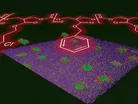Treating MRSA with nanotechnology and nanomedicine

Back in April 2011 researchers from IBM and the Institute of Bioengineering and Nanotechnology (IBN) announced that they had stumbled on “a nanomedicine breakthrough.” They discovered a new type of polymer which was able to detect and destroy bacteria that is resistant to antibiotics and infectious diseases such as MRSA. It is now hoped the discovery will have the potential to revolutionise treatments for MRSA and other superbugs which are becoming increasingly common in hospitals and healthcare environments across the world.
If commercially manufactured, these biodegradable nanostructures could be injected directly into the body or applied topically to the skin, treating skin infections through consumer products like deodorant, soap and hand sanitizer, as well as being used to help heal wounds, tuberculosis and lung infections.
To get a more up-to-date picture of how the discovery and development of this innovative new technique is progressing, Healthcare Global caught up with Dr James Hedrick, an IBM research scientist.
HG: Can you explain about the nanomedicine breakthrough that was made back in April 2011? What exactly was discovered?
JH: With the increased prevalence of antibiotic resistant infections, there is an urgent need for innovative antimicrobial treatments. One such area being actively explored is the use of self assembling cationic polymers. This relatively new class of materials was inspired by biologically pervasive cationic host defence peptides. We have developed together with our colleagues at the Institute of Bioengineering and Nanotechnolgy a class of cationic polymers that assemble into nanostructures that are biodegradable, biocompatible and have broad spectrum antimicrobial activity.
Exactly how do the nanostructures destroy the infections?
The cationic nanostructures can selectively target and disintegrate bacterial membranes that are negatively charged via electrostatic interaction and insertion into the membrane lipid domains, destroying the integrity of the membrane and hence, avoiding potential bacterial resistance.
How effective would this type of treatment be in treating infections and infectious diseases?
Our initial results are very promising. However, it is too early to say how this is going to work in animal models and beyond.
What would the benefits be to using nontechnology as a method of combating hard-to-treat infections and diseases?
There will be numerous benefits to applying this technology to combat infections. First and probably most important is the high activity of these polymers with selectivity. That is, they tend to go after the target and not other things in the body. For example, they show minimal hemolysis and cytotoxicity. Secondly, the ability to develop resistance is minimised due to the mode of action, lysis of the membrane. Finally, once they perform the targeted function, they degrade and do not end up in our water and food chains.
Since April, have there been any more discoveries made regarding the use of nanotechnology as a potential treatment for infectious diseases and MRSA?
We have significantly improved the activity of the polymer towards a broad spectrum of microbes with our colleagues at IBN. Specifically we have demonstrated high activity towards Gram-negative bacteria, a difficult target. We have also demonstrated activity against fungi, for which there is a limited number of drugs with targeted activity.
What does this now mean for the treatment of infectious diseases, like MRSA?
We feel that this may be significant. In the last decade, there has been an enormous increase in antibiotic-resistant bacteria, such as methicillin-resistant Staphylococcus aureus (MRSA), vancomycin-resistant Enterococcus (VRE) and fluoroquinolone-resistant E. coli. Most modern antibiotics act on specific molecular targets within bacteria. This yields therapeutic specificity but allows resistance development through mutation (among other mechanisms) since the bacterial cell morphology is generally preserved. In contrast, our polymers like certain cationic host defence peptides act on the entire cellular membrane via electrostatic attraction and subsequent pore generation. This may be very important in treating MRSA.
Are there any other ways that nanotechnology and its principles are being used in medical innovations or treatments?
This technology holds great promise for a number of areas in medicine including drug delivery, gene delivery, diagnostics and regenerative medicine. Many of these areas are currently under study especially in the delivery of drugs with limited solubility. For example, we have demonstrated that we can load these nanostructures with these drugs and make them of a size that permits facilitate long circulation times for passive delivery for cancer.
The Healthcare Global magazine is now available on the iPad. Click here to download it.



